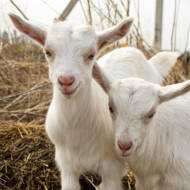
Two Goats, Two Different Paths: A Yom Kippur Message

When reading about the service of the two goats this coming Yom Kippur, let us be reminded of a life lived in the path of God versus a meaningless existence.
By Rabbi Ari Enkin, Rabbinic Director, United with Israel
The Torah describes in great detail the order of the service that the High Priest would perform on Yom Kippur in the Holy Temple. The Yom Kippur service was unlike the service of any other day, whether a regular weekday, Shabbat, or other holiday.
One of the unique features of the Yom Kippur service was the ceremony of the two goats. As the verse says:
“And he [Aaron, the High Priest] shall take the two goats…and he shall cast upon the two goats lots: one for God and one for Azazel. And Aaron shall present the goat upon which the lot for God was chosen and use it as a sin offering. But the goat on which the lot fell for Azazel shall be set alive before God, for atonement, and be sent away to Azazel into the wilderness.”
(Azazel is a very mysterious word, with some explaining it to be some kind of demon or devil or simply meaning “meaningless” or “waste.”)
On the latter goat, the one designated to Azazel, the verses tell us, “Aaron shall lay both of his hands upon the head of the goat and confess all the sins of the children of Israel and all their transgressions…and he shall put them upon the head of the goat and he shall send (the goat) away…into the wilderness.” The goat was then thrown over a cliff.
What a wild service! Two goats! One an offering and one thrown over a cliff. What’s going on over here?
In order to understand the ceremony of the two goats, it must be noted that they had to be almost identical and of equal value. The two goats were brought into the Temple, and the lottery would decide which animal would be the offering on the altar and which would be sent over the cliff in the wilderness. Identical beginnings, very different endings.
The animal being offered on the altar is slaughtered first, while the second goat observes the proceedings. The second goat is probably thinking to himself how lucky he is that he is alive! He wasn’t killed! He is probably overjoyed! Then, a short while later, the second goat is being led out of the Temple towards the desert and into the wilderness. He probably thinks that he is going for a pleasure walk on the Jerusalem hillsides. By this time he probably has a great view of the Dead Sea. He must think he “won the lottery” (no pun intended!) while his buddy had a tragic end.
However, we know what was in store for this second goat. He had no idea. But we know. We know he’ll be dead, too, in just a few minutes. If the goat would have known that in a few minutes he would end up tumbling down a mountainside, being ripped apart by the sharp stones, these thoughts would never enter his mind. It was the first goat that was truly the lucky goat.
It is explained that the ceremony of the two goats represents the two paths in which a person can live his or her life. The first goat, slaughtered on the Altar in honor of God, represents a life of Torah and good deeds. The second goat, dedicated to “Azazel,” represents a life far from God. It is only the former lifestyle that will be a life of meaning and value, a life that brings us close to God.
When reading about the service of the two goats this coming Yom Kippur, let us be reminded of a life lived in the path of God versus a meaningless life that is worth little more than a jump off a cliff.
